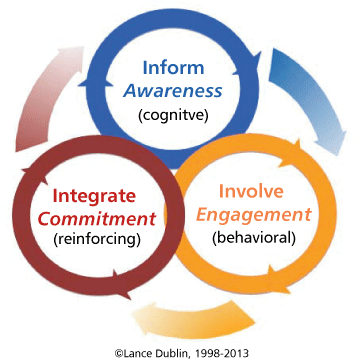As is well known and often stated, organizations do not change -- people do. Employees, managers, colleagues, partners, suppliers, customers -- one at a time and then many. Without change, people become stagnant and organizations die.
Change is certainly necessary. Change is hard. But what is a more useful insight is that change is truly internal; it happens in an inner space. Change is the result of a process rather than a series of transactions. As people construct a new world view in reaction to the stimuli around them, they generate new insights and understandings. This gives them a foundation from which to experiment with new behaviors -- to try them out and to experience the effects for themselves. Eventually they are able to internalize the change, leading them to act and behave in new ways. Ensuring the success of a change initiative such as a new technology therefore requires a process-based approach to providing opportunities and mechanisms for information and understanding, participation and engagement, as well as integration and reinforcement.
Change Implementation Rather Than Change Management?
Having worked for the past 35-plus years leading and supporting organizational change initiatives with a focus on new learning technologies, I've had the opportunity to learn firsthand from the successes and mistakes of masters, colleagues, and clients, as well as my own. Through these experiences I've realized the importance of the disciplines of change management and communications, training and support, and performance management. I've also reached "out of the box" to transfer principles and practices from both consumer marketing and systems thinking.
By drawing upon what I've found to be the strengths and weaknesses of these disciplines, I've developed an inclusive and process-based approach to change that I refer to as "change implementation." I've chosen the word "implementation" very consciously. Typically the goal of any new technology or organizational initiative is an observable and measurable change in attitudes and behavior. Organizations must be able to see and measure the results, to put these changes into practical effect (e.g., implementation) rather than supervising or controlling them (e.g., management). I offer this model for your consideration and feedback. I encourage you to try it out, modify it, improve it, and change it as you see fit -- so that it best works for you and your organization.
Change implementation draws upon these disciplines and applies principles of cognitive, behavioral, and social psychology. It focuses on that inner space of change where users are seeking insights about and answers to the ever-present "what's in it for me?" question. Within that space, the most powerful driver is value: do they understand the potential value the change represents, can they experience its value for themselves, and, finally, can they realize its value in a tangible way?
What Does It Look Like in Action?
The I-3 Change Implementation model shown in Figure 1 focuses on value and consists of three phases that form a reinforcing system in which each phase is a unique subsystem.

Figure 1 -- I-3 Change Implementation Model.
Phase 1: Inform -- Generate Awareness to Understand Value
Through information and messaging activities (i.e., marketing communications, or "marcom" as it is known), users, managers, and the organization are provided clear, consistent, and repeated answers to the "what, why, how, who, and when" questions. Most importantly, in this phase you begin to answer the "what's in it for me" question, which is essential for users to form their own understanding of the value of the change. The goal of this phase is to make sure the messages you want to be heard are heard and are in ways they will be recognized, recalled, and remembered.
Most organizations refer to this phase as communications, and all too often place too heavy a reliance on it to drive the change in attitudes and behaviors. However, there are few examples one can point to where words or trinkets (e.g., pens, t-shirts, mugs) have been the primary driver for the type of changes required.
Examples of specific activities during this phase include newsletters, presentations, emails, voicemails, documents, webcasts, websites, and Web announcements on the intranet.
Phase 2: Involve -- Generate Engagement to Experience Value
Just giving users and their managers answers to questions they may or may not in fact have is not enough. In order for the change to be successful, you must change their attitudes and behaviors as well as transfer necessary skills and knowledge. The goal of this phase is therefore two-fold: (1) have them internalize and personalize the benefits of the change so that it becomes theirs not just yours; and (2) provide them with the necessary skills and knowledge to be successful on day one and then be able to improve their ability to perform in the days, weeks, and months ahead. It is important therefore to design into both change management and training activities opportunities for users and their managers to have experiences of the change; to in effect "try it on," to ask questions, to practice and develop skills, and to generate their own insights about how to value the change.
Sandboxes and pilots are often successful activities in this phase, as well as training and support. However, organizations tend to overtrain at this point in the belief that users need to know more than they actually do on day one. Think about applying the concepts of "thin training" and timed support so that users and managers know what they need to know when they need to know it.
Specific activities during this phase also include department meetings and lunchroom fairs, hallway expos and road shows, video ads and online FAQs, job aides, and hotlines.
Phase 3: Integrate -- Generate Commitment to Realize Value
The long-term success of any change requires users and their managers to realize the value in real work situations. It is important to identify how the changes are reflected in the ongoing work and organizational processes and how the application of the new attitudes and behaviors and skills and knowledge will be reinforced. It is from these experiences on the job doing "real work" that the value of the change can be truly realized. Once this happens, it can more quickly become the "norm"; an integrated component of the work and work processes reinforced by the performance management system and not just another change du jour. In this way, the change also becomes part of the very fabric of the organization; critical to the success of the users and managers and the ongoing health, if not survival, of the organization as a whole.
Conclusion
More new technologies and organizational changes are headed your way. Change is hard work for sure, but no amount of hard work alone is enough. Only through the combination of hard work and the application of a well-thought-out approach to change implementation can you ensure your success. Repeat after me: "The soft stuff is the hard stuff."
We welcome your comments about this Advisor and encourage you to send your insights to us at comments@cutter.com.
[For more from the author on this topic, see "Learning and Organizational Change: The Soft Stuff Is the Hard Stuff ... Still."]
-- Lance Dublin, Senior Consultant, Cutter Consortium




